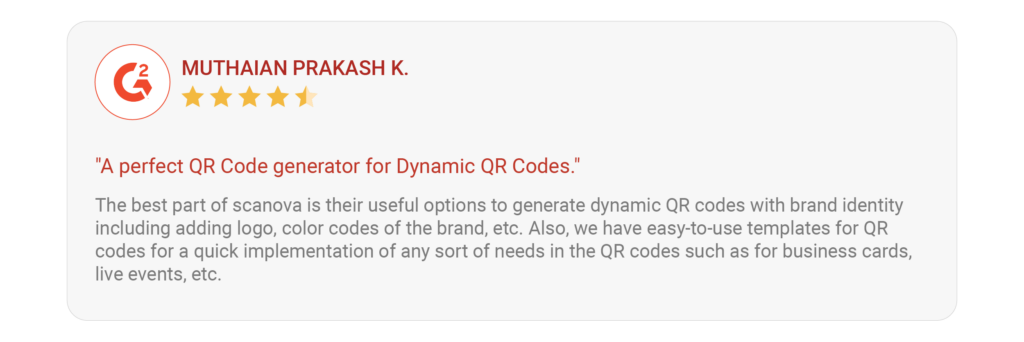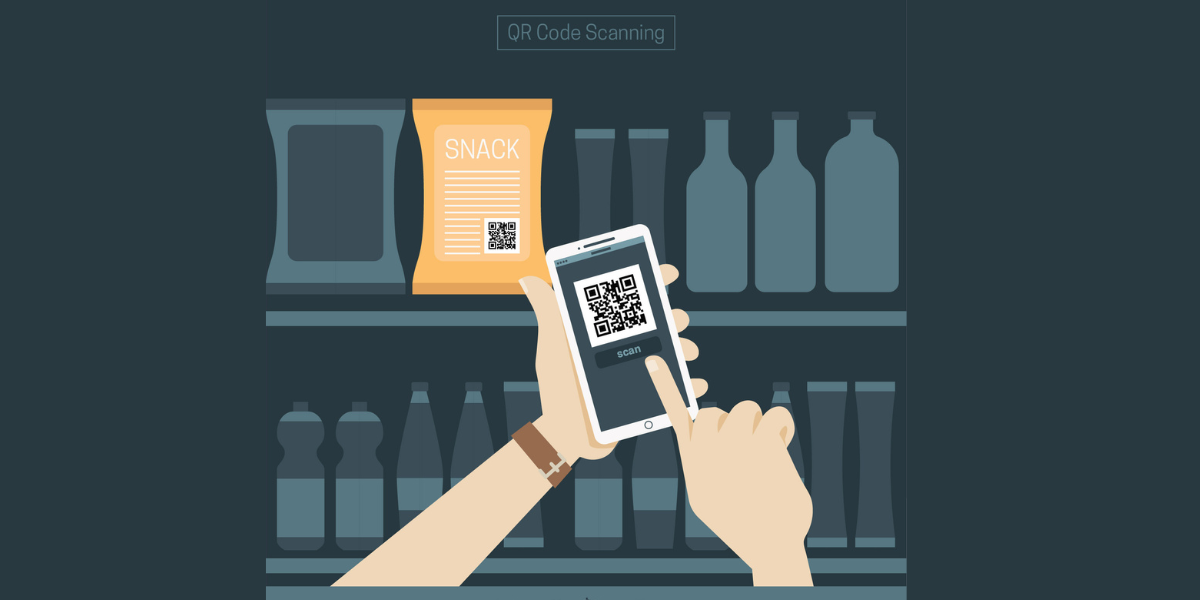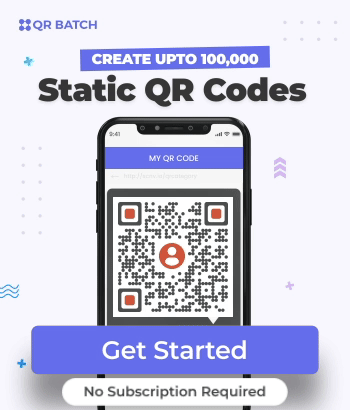Imagine this: you’re browsing through the aisles of your favorite store when you spot those small, pixelated wonders. But hold on, these QR Codes are more than meets the eye!
They are more than just cryptic squares; they lead to a world of convenience, information, and excitement. Join us on this exciting journey as we investigate the creativity behind QR Codes on product packaging and discover why they are generating such a fuss.
From scanning your bread to unlocking hidden treasures, let’s dive into why QRs are revolutionizing the shopping experience.
So, hold onto your hats – we’re about to embark on a ride to the future of retail!
A. What are QR Codes on product packaging
QR Codes on product packaging are those handy little squares found on everything from cereal boxes to shampoo bottles. They function as digital shortcuts that may be scanned with your smartphone to access a variety of important information.
QRs are like your secret weapon for smarter purchasing, whether you want to learn more about ingredients, read user reviews, or even get unique bargains. So, the next time you see one on a product, scan it and see where it leads you.
B. Who can use QR Codes on product packaging
QR Codes on product packaging are for everyone! Here’s who can get in on the action:
1. Manufacturers
They use QR Codes to give you the lowdown on their products – what’s inside, how they’re made, and any other important info you might want to know.
2. Retailers
They’re all about making your shopping experience easier. With QR Codes, they can offer you extra details about products and even hook you up with special deals.
3. Small businesses
They can use QR Codes to level the playing field against bigger competitors. By giving you quick access to info and reviews, they can win your trust and your business.
4. Marketing agencies
They get creative with QR Codes in their campaigns, using them to grab your attention, keep you engaged, and learn more about what you like.
5. Consumers
That’s you and me! We use QR Codes to get the scoop on products before we buy – from reviews to ingredients. They’re like our personal shopping assistants!
6. Food and beverage industry
QR Codes help us make informed choices about what we eat and drink. They tell us everything from where it’s from to what’s in it, so we can pick what’s best for us.
7. Healthcare sector
On medicine packaging, QR Codes provide important info like how much to take and any side effects. Plus, they make it easier to book appointments and access medical records.
8. Educational institutions
They use QR Codes to supercharge learning. In textbooks and learning materials, they provide extra resources and fun stuff to help us understand better.
At its flagship store, Puma, the shoe brand, introduced QR Codes on shoe tags. These QR Codes were linked to an augmented reality (AR) experience featuring Puma’s iconic feline mascot. Customers had the opportunity to interact with the mascot by capturing a selfie.
C. How to create QR Codes on product packaging
Since you need a large number of QR Code labels, creating them one by one isn’t practical. You’ll want to use an online bulk QR Code generator tool.
For our demonstration, we’ll be using QR Batch to create bulk QR Code labels. With QR Batch, you can create several types of QR Code batches, including:
– Website URL QR Codes
– Vcard QR Codes
– Plain Text QR Codes
– Serial Code QR Codes
– Random Code QR Codes
Here’s a step-by-step guide to creating QR Codes on product packaging:
1. Specify the data
You’ll need to create a spreadsheet with your data to generate QR Codes for website URLs, Vcards, or plain text. Follow our detailed guide for creating one.
For this article, we’ll focus on specifying data for text QR Codes. Simply:
i. Visit the QR Batch and select the Plain Text option.
ii. Upload your spreadsheet.
iii. Review the uploaded file by matching its columns with the QR Code fields. Confirm your selections.
iv. Once all details are entered, click Next.
2. Design your QR Codes
After specifying the data, you’ll see two QR Code designs: Standard and Custom Logo. You can proceed with either.
Customizing your QR Codes with a logo and brand colors can attract more scans than standard black-and-white ones. Customized QR Codes are ideal for marketing and promotions.
3. Specify label size and details
– After designing your QR Code batch, select the QR Code design.
– A pop-up will appear to define the batch name. Choose the export option “QR Code labels PDF.”
– Specify the QR Code size, indicating the labels per sheet (ranging from 1-80 labels per sheet).
– You’ll receive a comprehensive label specification, including sheet size, labels per sheet, margin, shape, and Avery compatibility. Review and click Next.
4. Make payment
– QR Batch charges only for the QR Codes you create, with rates decreasing as the number of QR Code labels increases.
– Estimate the batch price using the QR Batch Price Calculator.
– For instance, one QR Code costs $0.50, while 50 QR Codes cost $13 ($0.26 per QR Code).
5. Download your QR Code batch
– After payment, your QR Code Batch will be generated, taking a few minutes for smaller batches or up to an hour for larger ones.
– Download your batch from the Download Batch section, where you’ll receive notifications about the process and completion.
– Your QR Code Label PDFs will be in a zip folder. Unzip it, open a PDF, and scan a QR Code to test the output.
Now, you’re ready to print your QR Codes on compatible Avery or equivalent sheets using your home or office printer.
D. Why use QR Codes on product packaging
Using QR Codes on product packaging is like giving your shopping experience a turbo boost!
Here’s why they’re so awesome:
1. Easy access to info
Ever wanted to know more about a product without scouring the internet? QR Codes give you instant access to all the juicy details – ingredients, how it’s made, customer reviews, you name it!
2. Convenience at your fingertips
No more typing in long URLs or searching for info. Just whip out your phone, scan the code, and voila! Everything you need to know is right there, saving you time and hassle.
3. Special deals and discounts
Retailers often use QR Codes to offer exclusive promotions or discounts to savvy shoppers. Who doesn’t love a good deal, right?
4. Transparency and trust
Manufacturers can use QR Codes to be transparent about their products, building trust with consumers by sharing important information like sourcing, production processes, and certifications.
Here’s what our customers have to say about our product:

5. Enhanced engagement
Whether it’s interactive content, behind-the-scenes videos, or virtual tours, QR Codes make the shopping experience more engaging and fun!
6. Tech-savvy shopping
In today’s digital age, QR Codes are like your secret weapon for smarter shopping. Embrace the tech and make informed choices with just a scan of your phone.
7. Educational opportunities
For students and curious minds alike, QR Codes on educational materials provide access to extra resources, interactive content, and study aids, making learning more dynamic and enjoyable.
If they found that a store or brand wasn’t operating sustainably, 70% of US consumers indicated they would alter their shopping behaviors.
E. Where to use QR Codes on product packaging
Wondering where you can find those handy QR Codes on product packaging? Here’s the scoop:
1. Front label or box
Some products feature QR Codes right on the front label or box, making them easy to spot and scan.
2. Back or side panels
Manufacturers often include QR Codes on the back or side panels of product packaging. This space allows for more detailed information without cluttering up the main design.
3. Near product information
Look for QR Codes near product information or descriptions. They’re often placed strategically to provide quick access to additional details or resources.
4. On instruction manuals
For products that come with instruction manuals or guides, you might find a QR Code that links to video tutorials or troubleshooting tips.
5. Inside packaging
In some cases, QR Codes can be found inside the product packaging, offering surprises or bonus content to customers.
6. On promotional materials
Retailers may use QR Codes on promotional materials, such as flyers or posters, to drive traffic to their website or offer exclusive deals.
7. On store displays
QR Codes can also be found on store displays or shelf tags, providing shoppers with more information about featured products or promotions.
F. Benefits of using QR Codes on product packaging
Using QR Codes on product packaging has some pretty cool benefits:
1. Quick info access
With just a scan, you can find out everything you need to know about a product, like what’s inside, how to use it, or even where it’s from.
2. Engaging experience
QR Codes can link to fun stuff like videos or interactive content, making shopping more interesting and interactive.
3. No more guesswork
Forget hunting for info online or trying to decipher tiny print on labels. QR Codes give you the details you need in seconds, right from your phone.
4. Builds trust
Brands that use QR Codes to share info about their products show they’ve got nothing to hide. It’s all about transparency and earning your trust.
5. Smart marketing
Marketers can get creative with QR Codes, using them to offer special deals, collect feedback, or even run contests – all while tracking how customers engage with their campaigns.
6. Helps keep track
For businesses, QR Codes can be a lifesaver when it comes to managing inventory and tracking products from production to sale.
7. Stands out from the crowd
Brands that use QR Codes show they’re tech-savvy and customer-focused, setting them apart in a crowded market.
8. Extra learning
In educational settings, QR Codes can provide access to extra resources or interactive content, making learning more fun and engaging for students.
G. Best practices: QR Codes on product packaging
When it comes to using QR Codes on product packaging, there are a few golden rules to follow:
1. Keep it visible
Make sure your QR Code is easy to find and scan. It should be prominently displayed on the packaging without any obstructions.
2. Provide value
Give people a reason to scan your QR Code by offering something valuable in return, like exclusive discounts, additional product information, or entertaining content.
3. Test before launch
Always test your QR Codes to ensure they work properly on different devices and in various lighting conditions. There’s nothing more frustrating than a QR Code that doesn’t scan!
4. Shorten URLs
If you’re linking to a website, use a URL shortening service to create a QR Code with a simpler, more manageable link. This reduces the risk of errors and makes the QR Code look cleaner.
Brands that trust us:

5. Optimize for mobile
Remember that most people will be scanning your QR Code on product packaging with their smartphones, so make sure the linked content is mobile-friendly and easy to navigate.
6. Track performance
Use analytics tools to track how many people are scanning your QR Codes and what actions they’re taking afterward. This data can help you refine your marketing strategies and improve engagement.
7. Provide clear instructions
Include simple instructions on the packaging to let people know how to scan the QR Code on product packaging and what they can expect to find. This helps encourage more people to give it a try.
8. Stay relevant
Update the content linked to your QR Codes on product packaging regularly to keep it fresh and relevant. Whether it’s new product features, seasonal promotions, or user-generated content, keep the content up-to-date to maintain interest.
H. FAQs: QR Codes on product packaging
1. What are QR Codes on product packaging?
QR Codes are those square-shaped codes you often see on product packaging. They can be scanned with a smartphone camera to access additional information or content related to the product.
2. What information can I get from scanning a QR Code on product packaging?
It depends on the brand and product, but scanning a QR Code can give you access to a variety of information, such as product details, ingredient lists, usage instructions, promotional offers, or links to additional resources.
3. How do I scan a QR Code on product packaging?
To scan a QR Code, open the camera app on your smartphone and point it at the QR Code. Your phone should automatically recognize the QR Code and display a notification or prompt you to open a link or app associated with it.
4. Do I need special software to scan QR Codes?
Most smartphones come with built-in QR Code scanning capabilities in their camera apps. However, if your phone doesn’t have this feature, you can download a free QR Code scanning app from your device’s app store.
5. Are QRs safe to scan?
Generally, yes. QR Codes are just a way to encode information, similar to barcodes. However, it’s always a good idea to be cautious and only scan QR Codes from sources you trust to avoid potential security risks.
6. Can QR Codes expire?
Yes, QR Codes can be set to expire after a certain period or after a specific number of scans. This is often done for promotional purposes to create a sense of urgency or to ensure that outdated information isn’t accessed.
7. Do QR Codes work offline?
No, QR Codes typically require an internet connection to access the linked content. However, some QR Codes may contain static information, such as contact details or Wi-Fi network credentials, that can be accessed offline.
Summing Up
We hope you’ve discovered just how powerful these little squares can be! From unlocking a treasure trove of information to enhancing your shopping experience with interactive content, QRs are revolutionizing the way we engage with products.
If you’re still reading, you’ve learned everything about QR Codes on product packaging. If you have any questions, let us know in the comments.


